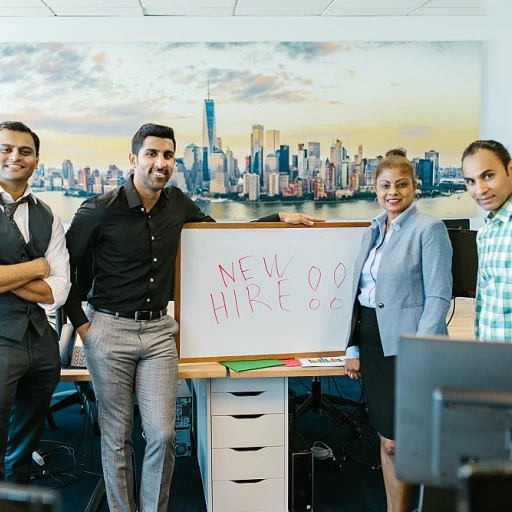
Understanding the Hiring Landscape
Grasping the Dynamics of Recruitment in Today's Job Market
In navigating the complexities of today's hiring landscape, one must first come to terms with the dynamic nature of recruitment and the sheer competition present in the market. The advancement of technology and global communication channels have transformed the way recruiters identify potential candidates, making it essential for companies to stand out. To truly understand this landscape, it's crucial to consider various factors that influence the recruitment process:- Job Market Trends: As demand for new skills increases, so does the range of opportunities available. Understanding these trends can give recruiters the upper hand in identifying suitable candidates with the right top skills.
- Social Media: Modern-day recruiting increasingly involves the use of social media platforms. These channels offer unique ways for companies to engage with potential candidates, enhancing employer branding and allowing recruiters to navigate the job market more effectively.
- Target Audience: A good grasp of who the ideal candidates are for a particular position allows the creation of a compelling job profile. Knowing the desired demographic will assist in tailoring messages that attract high-quality applicants.
- Competitive Job Environment: The need for quality candidates means organizations must be competitive both in terms of the roles they offer and the work culture they promote. This environment is continuously evolving, and staying informed is critical to securing talent.
Crafting the Perfect Job Description
Developing an Irresistible Job Profile
In today's competitive job market, crafting a compelling job profile is more crucial than ever. With potential candidates often sifting through numerous opportunities, your job description needs to stand out. It's not merely about listing duties; it's about painting a picture that aligns with both the role and the company's broader vision.- Define the Role Clearly: Highlight the essential skills and tasks clearly to attract suitable candidates. Focus on what distinguishes this role from others, providing insights into day-to-day work and potential growth opportunities.
- Showcase Employer Branding: Utilize this section to reflect your company's values and culture. Highlight what makes working at your company unique, and how the job contributes to the overall mission.
- Target the Right Audience: Precision in your job profile helps in recruiting the ideal candidates. By understanding who your target audience is, you can tailor your language and elements of the job description to attract that specific group.
- Incorporate Quality Standards: Emphasize high-quality and potentially necessary skills required for the position. This aids in the recruitment selection, ensuring that candidates are not only qualified but also a long-term fit for the company.
- Leverage Social and Media Platforms: Share the job profile on various social media and job boards to maximize reach. Tailoring content to be platform-appropriate can result in faster and more reliable sourcing of quality candidates.
Effective Candidate Sourcing
Maximizing Candidate Reach and Engaging Talent
In today's competitive job market, effective candidate sourcing is pivotal to finding the ideal talent for your organization. The process involves a strategic approach in attracting and engaging high quality candidates who possess the necessary skills and fit within your company's culture.
To begin with, understanding your target audience is essential. Knowing what potential candidates are seeking in their next role helps shape your recruitment strategy. Consider leveraging employer branding to appeal to talent by clearly communicating what makes your company a great place to work. This can be a differentiator in attracting top skills to your organization.
The use of online platforms is a cornerstone in the candidate sourcing process. Job boards and recruitment selection methods on social media channels are effective tools for reaching a broad audience. It's essential to create engaging content that resonates with potential candidates. A well-crafted job profile that highlights the key requirements and opportunities for growth will capture the interest of suitable candidates.
Recruiters and sourcing teams should not overlook the power of networking and word-of-mouth. Encourage employees to share job openings with their connections. This can lead to discovering fast reliable candidates who might not be actively searching but are open to new opportunities.
Another critical aspect of candidate sourcing is maintaining contact met potential candidates even if they are not ready to make a move immediately. Building long-term relationships with individuals who have been considered during past recruitment cycles can be beneficial when the right opportunity arises. This proactive approach keeps a pool of talent available and ready for selection when new positions open up.
Ultimately, the quality of the candidates sourced will reflect the effort put into the recruitment process. By prioritizing strategic sourcing techniques, recruiters can enhance their ability to identify and attract the right individuals for each role, ensuring a seamless integration into the workplace.
Streamlining the Interview Process
Creating a Seamless Process for Candidate Interactions
The interview stage is a critical juncture in the hiring experience, where recruitment teams and candidates come face-to-face. Crafting a process that is both efficient and respectful of the candidates’ time and effort is key in attracting high quality candidates who are keen to join your organization.
Leveraging Technology for Efficient and Reliable Results
In today's fast-paced recruitment environment, leveraging technology can streamline how recruiters schedule and conduct interviews. Tools such as automated scheduling systems and virtual interview platforms enhance efficiency, reduce turnaround times, and convey a strong employer branding message. Ensuring that the technology is user-friendly guarantees that potential candidates have an engaging and stress-free experience.
Focusing on the Core Skills and Competencies
The primary goal of any interview is to assess whether a candidate's skills and experience align with the job profile. Structured interviews that target specific skills sets are vital in maintaining consistency and fairness in candidate selection, minimizing bias, and enhancing the quality of your recruitment selection.
Creating a Balanced Evaluation Framework
Develop a balanced and objective evaluation framework to fairly assess candidates. Incorporating a diverse panel of interviewers helps capture a range of perspectives and ensures comprehensive feedback on a candidate’s fit for the role and organizational culture. This practice not only guarantees a thorough selection process, but also helps mitigate unconscious biases that may surface during recruitment.
The Human Element: Ensuring Fair and Respectful Engagement
Even in an era dominated by technology, human contact remains fundamental. Engaging with candidates in a respectful and attentive manner reflects the company’s commitment to a fair hiring process. Providing timely feedback and keeping candidates informed throughout the process enhances their experience and reflects positively on your brand in the competitive job market.
Evaluating Candidates Fairly
Evaluating Candidates with Precision and Fairness
Amidst the complexities of recruitment, ensuring fairness in kandidat selection is paramount. As recruiters navigate the job market, it's crucial to craft a comprehensive evaluation process that accurately reflects the skills and potential of each candidate. By employing a blend of structured assessment tools and keen insights, selecting high-quality candidates becomes more attainable.
One effective way to achieve this is by developing a consistent criteria list that aligns with the job profile and the company's goals. This list should comprise the requisite skills and experiences essential for the role. While crafting deze criteria, consider both hard skills and soft skills to gain a holistic view of each kandidaat's capabilities.
Furthermore, deploying multi-dimensional interviews can enhance the selection process significantly. This involves standardizing interviews across candidates, ensuring that each gets an equal opportunity to showcase their potential. Recruiters will find that weighing responses against a standardized rubric facilitates a more objective comparison.
Incorporating diverse viewpoints during the evaluation process can also increase the quality of assessments. Teams made up of members from different departments offer a broader perspective, leading to a more comprehensive selection decision. Moreover, embracing tools like social media platforms can provide additional insights into potential candidates, especially when verifying backgrounds and assessing cultural fit.
To further streamline this process, recruiters are encouraged to leverage technology. Platforms designed for recruitment selection often feature algorithmic evaluations that can reduce human biases, enhancing fairness. Ultimately, maintaining transparency throughout the selection journey not only fosters trust but also strengthens employer branding in a competitive job market.
For recruiters looking to continuously improve, regular feedback from selected and non-selected candidates can provide valuable insights into the effectiveness of the evaluation process. These insights, when addressed effectively, will result in a long-term refinement of recruiting strategies, ensuring fast reliable identification of top skills that candidates bring to the table.
Onboarding for Success
Welcome Your New Recruits Like a Pro
Successfully navigating the hiring landscape involves more than just finding the right candidate. A seamless onboarding process is crucial for converting potential candidates into effective team members. It’s an opportunity to solidify your employer branding and ensure new hires feel adequately prepared and welcomed to their new work environment. Here’s how you can enrich this essential part of recruitment.- Structured Onboarding Program: Create a well-structured onboarding program that outlines the recruitment selection procedures, job expectations, and company culture. This program should be designed to smoothly transition new employees, reducing initial stress and making them feel part of the team from day one.
- Setting Clear Objectives: During the initial weeks of selection, it’s vital to set clear and realistic objectives with measurable outcomes. This not only helps the employee understand their role better, but also enables recruiters to evaluate progress effectively, ensuring both parties are on the same page.
- Leverage Social Media for Engagement: Incorporating social media into your onboarding process can be beneficial. Encourage new hires to follow your company on various platforms, fostering a sense of belonging and offering them a channel to learn more about the company beyond the werving selectie office environment.
- Nurturing Long-term Relationships: Investing in onboarding is not just for immediate gains. By focusing on creating a positive experience, you’ll increase the likelihood of retaining high-quality candidates for the long term, contributing to a competitive job market edge.
- Regular Contact and Feedback: Maintaining regular contact met new recruits and providing consistent feedback during their initial months plays a pivotal role in their job satisfaction, motivation, and development. This practice ensures that they feel supported and valued, strengthening their commitment to the company.












